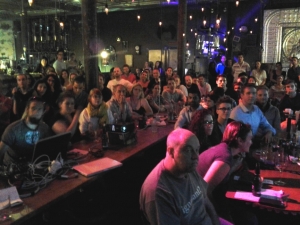Science Cafe Cape Town
29 October 2015
A week ago Thursday, October 29, I was honoured by the opportunity to speak to the Science Cafe Cape Town. Held at Truth Coffee, the Science Cafe offers “monthly meetups for anyone with a curiosity in science, a chance to chat with local experts about cutting-edge research in a relaxed setting.”
Indeed, the unique venue was ideal for an interactive conversation with an audience of more than one hundred. Following a brief introduction, I showed a short film produced while I was working as an embedded filmmaker and technician at the Mars Desert Research Station, Utah, in January 2014 with MarsCrew134. I then moved through two dozen slides in order to bring the audience into an awareness of the many organisations that are now working toward taking humans to Mars, the asteroids, and beyond. I introduced a few of the many technical and financial challenges, and offered topics for consideration, including “Why should we go to Mars?”
 For me, as a speaker, it was a most enjoyable event. My thirty minutes presentation was followed by an hour of questions, which is most unusual and incredibly fun. Thanks to all who attended, for such being the most engaging audience I have ever enjoyed.
For me, as a speaker, it was a most enjoyable event. My thirty minutes presentation was followed by an hour of questions, which is most unusual and incredibly fun. Thanks to all who attended, for such being the most engaging audience I have ever enjoyed.
I opened the evening with full admission that I am a “jack-of-all-trades, master-of-none” and promised to let the audience know if I could not answer a question asked. This kind of presentation is new to me. Informal and wonderfully engaging, it was as much a conversation with new friends as it was a lecture. Yet in that informality, I was not as accurate with some of my answers as I would have liked to have been.
This past week I have conducted a series of fact-checks, to correct some of my answers and to build upon the subjects addressed. What’s more, Kerry Gordon, co-founder of the Science Cafe Cape Town granted me the opportunity to edit and clean the audio recording of my presentation. In so doing, I was able to remove the inaudible questions (too far from the microphone) and tighten a few of my answers in order to be more concise. The total recording is now just under one hour, including the short film.
In this follow-up research process, I have learned a great deal. I hope you will as well.
CAUTION! The proverbial rabbit hole runs deep. Myriad pathways unfold when investigating such a tremendous topic as space exploration. Dive in, but don’t expect to stop … until you walk on the face of Mars or build a future such that your children’s children may climb aboard a massive vessel bound for a neighbouring star.
RESOURCES
- The Planetary Society
- Planetary Resources
- Deep Space Industries
- Virgin Galactic
- SpaceX
- Mars Society
- Africa to Moon
- British Interplanetary Society
- Initiative for Interstellar Studies
- Icarus Interstellar
- NASA on Mars
- ESA on Mars
- Indian Space Research Organisation
- Russian Federal Space Agency
- China National Space Administration
CORRECTIONS
- I stated the distance from the Sun to the Earth was similar to the distance from the Earth to Jupiter, and again the same distance to Saturn. This was not correct. The distance from the Earth to Jupiter is nearly 5x that of the Sun to the Earth. But yes, the distance from the Sun to Jupiter is approximately the distance from Jupiter to Saturn. To continue, Uranus is 2x the distance from the Jupiter to Saturn at 20 AU; Neptune another 10 AU. —source
- The average temperature on Venus is 460C (not 300C). —source
- Voyager was launched in 1977 (not 1978) and became the first human-made object to enter interstellar space in 2012 (not “last year”). —source
- Astronauts who live on the ISS for periods up to 6 months are required to exercise for approximately 2 hours per day (not 4.5). Even with rigorous exercise, astronauts have typically lost up to 0.4-1% of their bone density per month in space.—source
- The longest continuous stay in space is on-board the Russian MIR for 437 days, not the International Space Station for which the longest run is 223 days.—source
- It would take 73,000 years to travel to Proxima Centauri at the speed of Voyager I (17.3 km/s). This is approximately 2500 generations. At 100x this speed, we would need 25 (not 100) generations to arrive. —source
ADDITIONS & VALIDATIONS
- Concerning the discussion of how we determine if a moon of another planet has a liquid water ocean, there are in fact 5 methods for such an observation and conclusion:
- dampening of the moon’s magnetic field through monitoring the auroras
- observation of geysers
- spectroscopy
- orbital wobble
- gravimetry
The above expands upon my answer of spectroscopy and acceleration by the gravitational field (gravimetry). Further conversation with Stephen Potter, Head Astronomer at the South African Astronomical Observatory offers, “Visual size is a first rough guess. Orbital period and distance cannot give you the mass. You can put any mass at a specific period+distance. E.g. replace Earth with Jupiter and it will have the same period and distance. Moon masses can be refined by studying the deviations in their orbits as a result of their interactions with other moons. So this now becomes a more complicated N-body problem, which you refine with more longer term observations. e.g. JPL has one of the best solar system N-body simulations right now. Only once you get close with a flyby can you refine it further. I.e. your spacecraft becomes the test mass.” - Concerning construction materials on Mars, yes, silica and iron are prevalent, as stated, but it is also believed that magnesium, aluminum (aluminium for those who prefer the British spelling :), calcium, and potassium are abundant, as discovered through the sampling of soil on Mars, and inspection of meteorites which originate from Mars. —source
- My reference to “not likely having calcium-based stone” for use as a construction material (cement) was in reference to limestone (calcium carbonate) which is formed primarily from the remains of marine life forms. Carbonates have been discovered on Mars using spectrometers on-board Spirit and the Mars Reconnaissance Orbiter, which provides evidence for a warmer, wetter past. (source) But for there to be limestone as we have on Earth, there would have had to have been many hundred of millions of years of calcium-bearing marine lifeforms, which has not, to date, been determined.
- To confirm the question of the young man to my left, yes, all planets are the same age as they were all formed from the same accretion disc orbiting our newly formed sun, between 4.4-4.6 billion years ago. —source
- While I correctly differentiated electromagnetic radiation from particle radiation, I could have further discussed “ionizing” radiation as the type which causes harm to human tissue. (source). However, per the question by the woman sitting directly to my front, given my current understanding, it would require radioactive isotopes, not highly energetic particles (“cosmic rays”) to cause food used as a radiation barrier, to become poisonous to the astronauts who would consume it. This requires further investigation …
“Cosmic rays are immensely high-energy radiation, mainly originating outside the Solar System. They may produce showers of secondary particles that penetrate and impact the Earth’s atmosphere and sometimes even reach the surface. Composed primarily of high-energy protons and atomic nuclei, they are of mysterious origin.”
“The term ray is a historical accident, as cosmic rays were at first, and wrongly, thought to be mostly electromagnetic radiation. In common scientific usage high-energy particles with intrinsic mass are known as “cosmic” rays, and photons, which are quanta of electromagnetic radiation (and so have no intrinsic mass) are known by their common names, such as “gamma rays” or “X-rays”, depending on their origin.”
“Galactic cosmic rays are one of the most important barriers standing in the way of plans for interplanetary travel by crewed spacecraft. Cosmic rays also pose a threat to electronics placed aboard outgoing probes. In 2010, a malfunction aboard the Voyager 2 space probe was credited to a single flipped bit, probably caused by a cosmic ray. Strategies such as physical or magnetic shielding for spacecraft have been considered in order to minimize the damage to electronics and human beings caused by cosmic rays.”—verbatim from source - I was correct in stating that Mars habitats will not have windows, at least not until we employ something like Star Trek’s transparent aluminum (which I learned is real!) as a shield to radiation. However, after the Q&A, a gentleman suggested that sunlight could be bounced into an otherwise radiation protected greenhouse (meaning, covered in soil). By selecting the coating on the mirror, you could determine what wavelength of light is reflected. However, if this is the case, then it would stand to reason that the human habitats would also have windows, even if tucked back, beneath an shielded roof. However, without a magnetic field and atmosphere 1/1000 the thickness of our own at sea level, the cosmic rays may yet penetrate the domicile through the window, even if travelling through the thickest part of the Martian atmosphere. This requires further investigation …
- The risk of radiation exposure is not as bad as we had thought, for a long-term manned mission to Mars. Results from Curiosity rover suggest that a mission consisting of a 180-day journey to Mars, a 500-day stay, and a 180-day return flight to Earth would expose astronauts to a cumulative radiation dose of about 1.01 sieverts. For comparison, the European Space Agency limits its astronauts to a total career radiation dose of 1 sievert, which is associated with a 5% increase in lifetime fatal cancer risk.—source
- Per the photograph of the “blueberries” on Mars, a concretion is a hard, compact mass formed through precipitation of mineral cement between particles. It is found in sedimentary rock and soil. This process can make the concretions harder and more resistant to weathering than the surrounding rock or soil.—source
- Jet Propulsion Laboratory (JPL) lost contact with Spirit after last hearing from the rover on March 22, 2010. Attempts were continued until May 25, 2011, bringing the total mission time to 6 years 2 months 19 days—25 times the original planned mission duration. —source
- For the gentleman who after the Q&A asked about the formation of our Moon, I found this page by NASA’s Jen Heldmann. Yes, the current theory remains that of a large impact. The difference from prior theories is that the Moon formed not from a lump of molten rock thrown into orbit by the impact, but by the accumulation of vaporised material from both the proto-Earth and the massive (Mars sized) object with which it collided.
- On the topic of nuking Mars, “Elon Musk details his plan to bomb Mars saying constant ‘nuclear pulse explosions’ would create double suns to heat the planet”. Read more …
- On the topic of teleportation, this is incredibly complex and wonderfully engaging, far beyond Captain Kirk arriving to the transporter room in duplicate (while wonderfully entertaining). I provide just a few links to stimulate further reading:
- Quantum Entanglement (definition) – www.wikipedia.org
- Spooky Interactions (recent breakthrough) – www.nytimes.com
- Teleportation (definition) – www.wikipedia.org
- Teleportation (at IBM) – researcher.watson.ibm.com
- Quantum Teleportation (definition) – www.wikipedia.org
- Quantum Teleportation (research article) – www.nature.com

